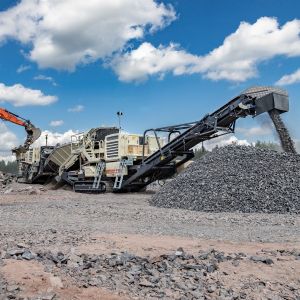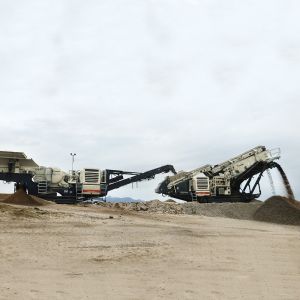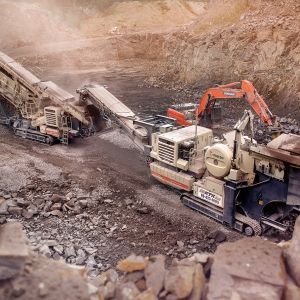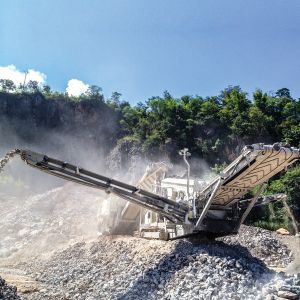What are jaw crushers?
- A jaw crusher is a crucial component in mining and ore processing plants, performing the primary crushing of rock and mineral ore to reduce and control the size of materials for further sizing, shaping, beneficiation and processing.
- These compression crushers are designed to tackle dry to slightly wet materials, without stickiness, and are adept at handling heavy mining and quarried materials as well as recycling applications.
- Primarily employed as primary (First stage) crushers, their exceptional ability lies in breaking down some of the most substantial and resilient materials into more manageable pieces, paving the way for subsequent processing with other specialized crushing equipment.
How do jaw crushers work?
- Central to the operation of all jaw crushers are two integral components: a fixed jaw and a movable or swing counterpart. These work in tandem, with the movable jaw executing a reciprocating motion that compresses and crushes rock or ore against the steadfast fixed jaw. This process occurs within the designated zone between the two jaws using manganese-wearing parts called ‘liners’.
- The overarching principle guiding jaw crushers is a compression action. A V-shaped alignment houses the fixed jaw, serving as the immovable surface that facilitates the initial breakage. Simultaneously, the movable jaw, in a swinging motion, exerts force on the incoming material, compelling it against the unyielding surface of the fixed jaw. This orchestrated interplay ensures the effective reduction of large-sized rocks, ore, or other materials.
What are the advantages of using a jaw crusher?
- Low Maintenance and Cost-Effectiveness: Offering a practical edge, jaw crushers are known for their low maintenance requirements, translating to cost-effectiveness over the long term. This makes them a reliable and economical choice.
- Adjustable Discharge and Durability: Users can customise discharge settings that ensure flexibility in the output, catering to diverse needs. Further, jaw crushers are renowned for their durability, with robust construction contributing to extended operational lifespans.
- Versatility in Material Handling: The capability to handle a wide range of materials. Whether dealing with heavy mining, quarried substances, sand and gravel, or recycling materials, jaw crushers prove versatile in accommodating varied demands.
- Minimal Fine Materials and Dust Output: The propensity to generate minimal fine materials during the crushing process. This characteristic is crucial in maintaining a cleaner and more efficient work environment.
What is the difference between a jaw crusher and a cone crusher?
- Primary vs. Secondary Crushing: Jaw crushers are primarily utilized for initial material reduction crushing tasks, while cone crushers are used in secondary crushing, refining materials that have already undergone primary crushing stages.
- Processing Capacity: A key differentiator is the processing capacity. Jaw crushers, designed for robust primary crushing, often handle larger volumes of raw material at a time. Cone crushers, tailored for secondary crushing, typically process smaller batches of pre-crushed material.
- Production Capacity: Reflecting their primary and secondary roles, jaw crushers and cone crushers exhibit differences in production capacity. Jaw crushers typically produce more quantities of crushed material, whereas cone crushers prioritize smaller, higher-quality final products.
- Final Product Quality: While the product from a jaw crusher may be coarser, cone crushers produce finer, better-shaped, and higher-quality final products.
What are the different types of jaw crushers?
- Blake Jaw Crusher: This crusher has the swing jaw pivoted at the top, a fixed receiving area, and a variable discharge opening. The most movement occurs at the bottom, which can lead to choking.
- Dodge Jaw Crusher: Similar to the Blake crusher, the Dodge crusher has a movable jaw that moves towards and away from the stationary jaw, and is preferred for crushing softer particles.
- Universal Jaw Crusher: This type has a “V”-aligned fixed jaw and a movable jaw on an eccentric shaft, creating an elliptical motion.
- Overhead Eccentric Jaw Crusher: Features a swing jaw suspended on the eccentric shaft, enabling a lighter, more compact design with high capacity.
- Single Toggle Jaw Crusher: Known for its simple structure, this crusher has a single toggle plate at the bottom of the swinging jaw and can crush hard materials.
- Double Toggle Jaw Crusher: The swing jaw in this crusher also suspends from an eccentric shaft, offering a compact design and the capability to handle tougher materials due to its heavy-duty construction.
How do you maintain a jaw crusher?
- Routine Inspection: Regularly inspect the machine for any visible signs of wear or damage. A proactive approach to inspection aids in the early detection of issues, preventing potential complications and ensuring prolonged operational efficiency.
- Controlled Feed Size: Adhere to specified feed size ranges to prevent overloading. Operating within the designated limits safeguards against unnecessary stress on the equipment, contributing to its longevity.
- Lubrication System: Use the correct oil grade in the lubrication system. Adequate lubrication is essential for reducing friction and wear between moving parts, enhancing the overall performance and durability of the jaw crusher.
- Timely Parts Replacement: Regularly check and promptly replace any worn or damaged parts. This proactive approach mitigates the risk of system failures and ensures that the jaw crusher operates at its optimal capacity.
By adhering to these maintenance practices, you contribute to the sustained efficiency and longevity of your jaw crusher, minimizing downtime and maximizing its operational lifespan.
What are the factors affecting the performance of a jaw crusher?
- Material Hardness and Abrasiveness: The inherent characteristics of the material being crushed are paramount. Harder and more abrasive substances demand increased energy input for effective crushing, impacting the overall efficiency of the jaw crusher.
- Material Humidity: High levels of humidity can lead to material adherence within the crushing chamber, potentially causing blockages and impeding the discharging port. This, in turn, hampers crushing efficiency and reduces throughput.
- Conveyor Belt Installation: The installation of the conveyor belt plays a pivotal role. Given the high-speed operation of the jaw crusher, a well-designed and smoothly functioning conveyor belt system is crucial. It ensures the seamless transportation of various finished products to their designated locations, directly influencing the overall output.
- Feed Size and Gradation: The size and gradation of the feed material impact the crusher’s performance. Properly managing the feed size within specified limits prevents overloading, contributing to efficient crushing operations.
- Operational Settings: The correct adjustment of operational parameters, including closed side settings and stroke, is vital. Incorrect settings may lead to suboptimal performance, affecting both the throughput and the quality of the final product.
- Maintenance Practices: Regular and proactive maintenance significantly influences performance. Neglected maintenance can result in increased wear, part failures, and decreased efficiency over time.
- Crusher Design and Configuration: The specific design and configuration of the jaw crusher, including the chamber geometry and the kinematics of the crushing process, play a fundamental role in determining overall performance.
Understanding and managing these factors collectively contribute to optimizing the performance of a jaw crusher, ensuring its reliability and efficiency in various operational conditions.
How do you adjust the CSS of a Jaw Crusher?
The CSS (Closed Side Setting) of a jaw crusher is the gap between the two jaw plates in the closed position. Adjusting the CSS is crucial for controlling product size and ensuring the desired outcome. Follow these steps to adjust the CSS:
- Check the manufacturer’s guidelines: Refer to the manufacturer’s instruction manual for your specific jaw crusher model that discusses specific details on the adjustment process and any safety precautions to be followed.
- Safety precautions: Ensure that the jaw crusher is turned off and isolated from power sources before attempting any adjustments, and use appropriate personal protective equipment (PPE).
- Use the adjustment mechanism: Most jaw crushers have a hydraulic or mechanical system for adjusting the CSS. Follow the manufacturer’s instructions for using the adjustment mechanism. Typically, there will be a control panel or lever that allows you to move the jaw plates closer together or farther apart to adjust the CSS.
- Measure the CSS: After adjusting, it’s important to measure the CSS to ensure it meets the desired specifications. This can be done using a gap measurement tool or by visually inspecting the gap between the jaw plates.
- Test the crusher: Once the CSS has been adjusted, run a test with sample material to ensure that the product size meets the desired specifications. Make further adjustments if necessary.
- Document adjustments: Keep records of any CSS adjustments made to the jaw crusher for future reference. This will help ensure consistency in product size and performance.
It’s important to remember that adjusting the CSS can affect the throughput and efficiency of the jaw crusher, so it’s essential to strike a balance between achieving the desired product size and maintaining optimal performance. Regularly monitor and adjust the CSS as needed for optimal operation.



